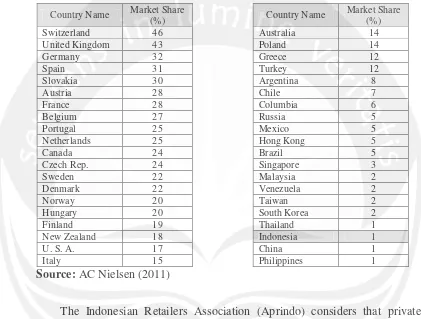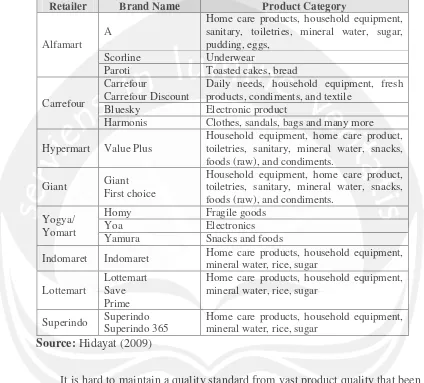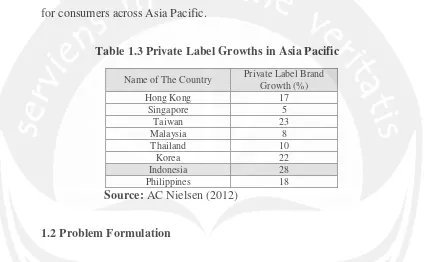CHAPTER I
INTRODUCTION
1.1Background
As private label brands are well recognized in developing countries, big retailers from industrialized countries have entered global markets for a number of reasons, including: mission to search a better economic scale and scope, a need to diversify risk, and a need to find new market when a retailer becomes too big for its home market (Corstjens and Lal, 2010). It is not surprising that retailers from more advanced countries bring their private label brands to Indonesia just about recently. The power of choice caused by numerous retailers‟ stores operating in Indonesia makes Indonesian consumers have more choices of products with low prices on a daily basis. Market expansion, economic crisis and inflation in some ways have encouraged Indonesian shoppers to be actively searching for values for money and Every Day Low Price (EDLP) promotions for private label brands.
AC Nielsen report (Media Post News, 2009, in thought of food) shows that the majority of societies have private label brands in their repertoire (cited in Nenycz-Thiel, 2010). Via Electronic Point of Sale (EPS) information, loyalty programs, and e-commerce they gathered information to develop a unique private label product that will become a tough competitor for manufacturer brand (Lepir, 2001).
In his book „Private Label Strategy‟ Kumar and Steenkamp (2007) pointed out that private label brands have dominated sales in food and non-food categories, i. e.: milk, eggs and bread (in thought of food); toilet tissue, cups and plates and trash bag (non-food). According to Private Label Manufacturers Association (PLMA, cited in Beverage Industry, 2003) nearly $50-billion segment of the retailing business that is achieving new levels of growth every day in the U. S. and another report by Beverage Industry (2003) private label foods and beverages are continuing to increase the pressure on the bigger name of manufacturers when it comes to price and positioning.
AC Nielsen‟s blog website (Global Private Label Report: The Rise of the
though the promotion activity gets pretty heated. In D. I. Yogyakarta the number of minimarts and supermarkets has been increasing many retailers compete to get more profit and drag a customer to shop even more by giving them more brand portfolio to choose.
Table 1.1 Private Label Brand: Country and Market Share
Country Name Market Share (%) Switzerland 46 United Kingdom 43
Germany 32
Spain 31
Slovakia 30
Austria 28
France 28
Belgium 27
Portugal 25
Netherlands 25
Canada 24
Czech Rep. 24
Sweden 22
Denmark 22
Norway 20
Hungary 20
Finland 19
New Zealand 18
U. S. A. 17
Italy 15
Country Name Market Share (%) Australia 14
Poland 14
Greece 12
Turkey 12
Argentina 8
Chile 7
Columbia 6
Russia 5
Mexico 5
Hong Kong 5
Brazil 5
Singapore 3
Malaysia 2
Venezuela 2
Taiwan 2
South Korea 2
Thailand 1
Indonesia 1
China 1
Philippines 1 Source: AC Nielsen (2011)
medium scale enterprises to supply all of their private label brand products. But, quality standards remain a problem in Carrefour Indonesia.
Table 1.2 Private Label Brands in Indonesia
Retailer Brand Name Product Category
Alfamart A
Home care products, household equipment, sanitary, toiletries, mineral water, sugar, pudding, eggs,
Scorline Underwear
Paroti Toasted cakes, bread
Carrefour
Carrefour
Carrefour Discount
Daily needs, household equipment, fresh products, condiments, and textile
Bluesky Electronic product
Harmonis Clothes, sandals, bags and many more
Hypermart Value Plus
Household equipment, home care product, toiletries, sanitary, mineral water, snacks, foods (raw), and condiments.
Giant Giant First choice
Household equipment, home care product, toiletries, sanitary, mineral water, snacks, foods (raw), and condiments.
Yogya/ Yomart
Homy Fragile goods Yoa Electronics Yamura Snacks and foods
Indomaret Indomaret Home care products, household equipment, mineral water, rice, sugar
Lottemart
Lottemart Save Prime
Home care products, household equipment, mineral water, rice, sugar
Superindo Superindo Superindo 365
Home care products, household equipment, mineral water, rice, sugar
Source: Hidayat (2009)
believe when the price is high the quality must worth the dime (www.kompasiana.com).
[image:5.595.90.514.254.516.2]Retailers must understand what makes people choose private label brand is that just because of the name (brand) or price and quality perceptions. Another AC Nielsen research (2012) identifies the key trends on market shifts in the grocery sector in Asia Pacific. The grocery price remains a point of argument for consumers across Asia Pacific.
Table 1.3 Private Label Growths in Asia Pacific
Name of The Country Private Label Brand Growth (%)
Hong Kong 17
Singapore 5
Taiwan 23
Malaysia 8
Thailand 10
Korea 22
Indonesia 28
Philippines 18
Source: AC Nielsen (2012)
1.2Problem Formulation
Based on the background stated earlier this study does research on the subject matters of: “Consumer Perception of Private Label Brands among
1. What are the important attributes for young consumers when they purchase food-related product (in terms of private label brands)?
2. What are the beliefs and perceptions of private label brands among the young consumers?
3. How accurate do young consumers recognize private label brand names? Based on the problems mentioned above, the formulation of the problem is what are the demographic background, product attributes, beliefs, perceptions and recognition of private label brands on a young consumer in D. I. Yogyakarta?
1.3Research Objectives
Based on the problem formulation mentioned above, the research objectives that will be done as followed:
1. To examine which product attributes that contribute to private label brand purchase decision among young consumers.
2. To investigate the beliefs and perceptions of private label brands among young consumers.
3. To analyze how accurate young consumers in recognizing private label brand names.
1.4Research Scopes
Research scopes were set to conclude the aims of this study. The scopes of this research are:
1. This study replicated a previous study by Lupton, Rawlinson and Braunstein (2010) who investigated a research paper of “Private Label Branding in China: what do U. S. and Chinese students think?” in a
university located in the western part of U. S. and a large university in Hefei, China.
2. Descriptive study is used to explain the individual selections of private label brands.
3. Indonesia has been chosen because it is one of the Asian countries which private label brands share grows bigger (AC Nielsen, 2011).
1.5Potential Academic Contribution
There are three contributions of the study:
2. At the managerial level, this research can provide an important insight for retailers that work on private label brands, with the concern of demographic background, beliefs, perception of private label brands and private label brand name recognition.
3. Furthermore, these two studies (the original work of Lupton et. al. (2010) and the current study) will give a comparison of the differences and similarities of personal preference for private label brands.
1.6Research Structure
This study arranges in a systematic writing, as follows:
Chapter 1: Introduction
This first chapter states the research proposal of “Young Consumers‟
Perception of Private Label Brands in D. I. Yogyakarta”. Background part
explains the background of the study and the following part clarifies the contribution of the research.
Chapter 2: Literature review
Chapter 3: Research Methodology
The third chapter communicates in detail about the research method such as data, data collection methods and tool to explain. This part becomes important because in this the step of data collection.
Chapter 4: Analysis and Findings
The fourth chapter is the main chapter. It connects the data collection to the analysis and research findings. The research findings give the idea to draw conclusions and managerial implications.
Chapter 5: Conclusion and Managerial Implication


